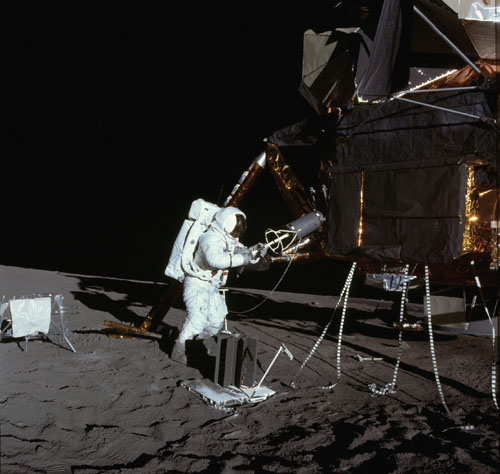
This Article From Issue
November-December 2011
Volume 99, Number 6
Page 462
DOI: 10.1511/2011.93.462
It’s a fact of the laws of thermodynamics: There’s always going to be some energy lost as heat when a device is doing work. Car engines, for instance, create a tremendous amount of heat in the process of moving vehicles. Industrial processes, such as glass making and steel milling, also produce a lot of thermal waste. Although it’s not possible to reclaim 100 percent of the loss, waste heat is potential energy that could be put to work making electricity—if it could be captured and converted efficiently.

Image courtesy of NASA.
One possible method is called thermoelectrics. NASA has been doing extensive work in this field since the 1950s, and has developed semiconductor materials that can turn heat directly into electricity with reasonable efficiency. A thermoelectric generator looks a lot like a transistor circuit, with electrons flowing from a hot side to a colder side. “These systems, being all solid state, are very reliable and were used on space missions where there’s no chance to maintain them,” says Jeff Snyder, a materials scientist at the California Institute of Technology. “For example, thermoelectric generators have been used by NASA to power deep-space probes, such as Voyager, that go beyond the orbit of Mars and can’t use sunlight to make electricity.”
Back on Earth, Snyder and his colleagues have been working on improving the efficiency of thermoelectrics for use on the ground. As is the case in much current research in materials, nanotechnology has been a popular approach: Researchers, including Snyder, have looked at ways to restructure thermoelectric materials on the nanometer level. “But we were getting confused as to where the improvements were coming from. So we decided to keep stripping off the complexity and try to make a simpler material,” Snyder says. He and his colleagues realized that some of these simpler materials, made with careful alloying of certain metals, worked just as well as the nanostructured ones. “In the end we said, okay, let’s forget the nano for now and see how well we can do with just alloys. In a sense, it can be thought of as a low-tech, old-fashioned method. But the problem with nanostructures is that the understanding of what they do is a lot poorer than we like to make it out to be.” Once the researchers have a better idea of the alloys’ capabilities, says Snyder, further improvements with nanostructures could be possible.
Snyder’s group began by working with the standard semiconductor for thermoelectrics, lead telluride. A thermoelectric material’s efficiency in turning heat input into electrical output is based on its figure of merit, a complicated calculation that involves conductivity and other properties that change with temperature. Lead telluride typically has a figure of merit of 1, but as Snyder’s group reported in the May 5 issue of the journal Nature, they have been able to show reproducibly that their alloy has a figure of merit of about 1.8, a significant improvement. Their accomplishment depends on maximizing the number of channels available for electrons to flow through the semiconductor.
Lead telluride, like other semiconductors, has what can be thought of as multiple “valleys” of energy that can conduct electrons. But the valleys don’t inherently conduct at the same energy levels unless they are “tuned” to do so. Snyder and his colleagues accomplished this tuning by adding precise amounts of dopants, materials that are similar to lead and telluride but have different numbers of electrons. When they replaced some of the tellurium with selenium, it shifted the energies of the conducting valleys just enough to converge them. “If one band is a much higher energy than the other, when you pour the electrons in, they only go to the lowest-energy one; they don’t touch the highest-energy band,” Snyder says. “So what you do is match the energy of the two bands, so that when you pour the electrons in, they go to both bands, and you get extra channels of conduction.”
Additionally, they replaced some of the lead, which donates two electrons in chemical bonds, with sodium, which only donates one. This substitution creates “holes” in the material where electrons should have been, which gives the electrons space to move into, thereby conducting electricity. The different masses of the added dopants also break up vibrations and reduce the thermal losses of the material, meaning it can channel heat better and thus capture more of its energy. “Heat is vibrating atoms, so when the atoms are well glued to each other, they conduct heat,” Snyder explains. “When they wiggle on one side, the wiggling quickly moves to the other side and conducts that wiggling energy, heat, from one side to the next.”
In the end, the team’s breakthrough wasn’t in a single area, but in a set of smaller factors combining correctly. “If you were missing one step, if you didn’t have the doping right but you had the selenium, you would not have gotten the high figure of merit. So we’ve got to have all our stars aligned in order to get this convergence,” Snyder says.
Snyder hopes that the improved thermoelectric material might be used in smaller waste-heat applications. Large systems, such as power plants, can use steam engines with higher efficiency for heat recovery. “It would be very costly, heavy and difficult to put a steam engine in your car to recuperate the exhaust heat,” Snyder says. “The advantage of thermoelectric is it’s all solid state, the system is relatively compact and has low maintenance, so we’re hoping that gives us a bit of a benefit in industrial and automotive waste-heat recovery.”

American Scientist Comments and Discussion
To discuss our articles or comment on them, please share them and tag American Scientist on social media platforms. Here are links to our profiles on Twitter, Facebook, and LinkedIn.
If we re-share your post, we will moderate comments/discussion following our comments policy.